Star is a huge, shining ball in space that produces a tremendous amount of light and other forms of energy. The sun is a star, and it supplies Earth with light and heat energy. The stars look like twinkling points of light—except for the sun. The sun looks like a ball because it is much closer to Earth than any other star.
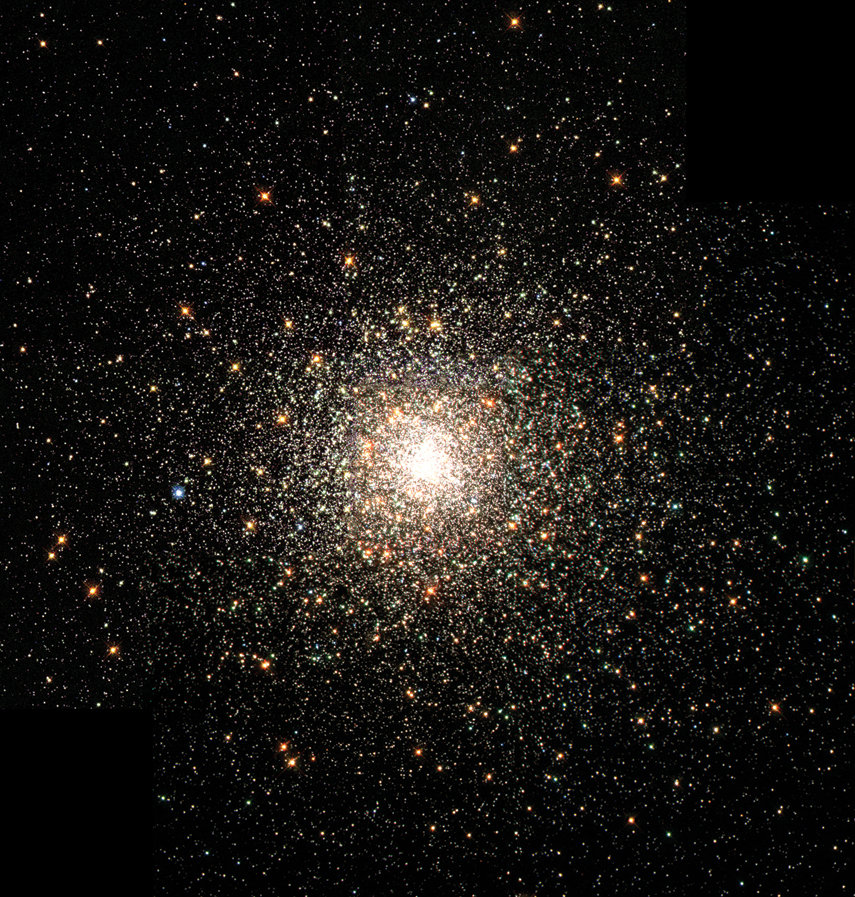
The sun and most other stars are made of gas and a hot, gaslike substance known as plasma. But some stars, called white dwarfs and neutron stars, consist of tightly packed atoms or subatomic particles. These stars are therefore much more dense than anything on Earth.
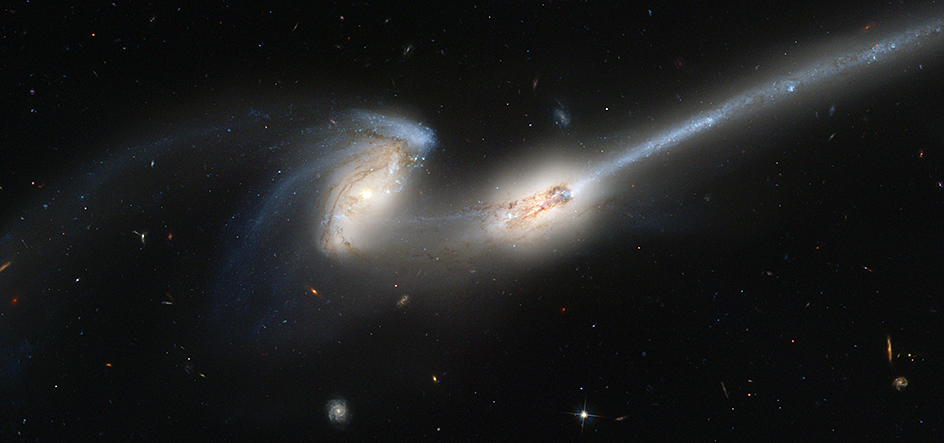
Stars come in many sizes. The sun’s radius (distance from its center to its surface) is about 432,000 miles (695,500 kilometers). But astronomers classify the sun as a dwarf because other kinds of stars are much bigger. Some of the stars known as supergiants have a radius about 1,000 times that of the sun. The smallest stars are the neutron stars, some of which have a radius of only about 6 miles (10 kilometers).
Astronomers think that from about 50 to 75 percent of all stars are members of a binary system, a pair of closely spaced stars that orbit each other. The sun is not a member of a binary system. However, its nearest known stellar neighbor, Proxima Centauri, is part of a multiple-star system that also includes Alpha Centauri A and Alpha Centauri B.
The distance from the sun to Proxima Centauri is more than 25 trillion miles (40 trillion kilometers). This distance is so great that light takes 4.2 years to travel between the two stars. Scientists say that Proxima Centauri is 4.2 light-years from the sun. One light-year, the distance that light travels in a vacuum in a year, equals about 5.88 trillion miles (9.46 trillion kilometers).

Stars, like people, have life cycles—they are born, pass through several phases, and eventually die. The sun was born about 4.6 billion years ago and will remain much as it is for another 5 billion years. Then it will grow to become a red giant. Late in the sun’s lifetime, it will cast off its outer layers. The remaining core, called a white dwarf, will slowly fade to become a black dwarf.
Other stars will end their lives in different ways. Some will not go through a red giant stage. Instead, they will merely cool to become white dwarfs, then black dwarfs. A small percentage of stars will die in spectacular explosions called supernovae.
The stars at night
If you look at the stars on a clear night, you will notice that they seem to twinkle and that they differ greatly in brightness. A much slower movement also takes place in the night sky: If you map the location of several stars for a few hours, you will observe that all the stars revolve slowly about a single point in the sky.
Loading the player...Exoplanets
Twinkling of stars
is caused by movements in Earth’s atmosphere. Starlight enters the atmosphere as straight rays. Twinkling occurs because air movements constantly change the path of the light as it comes through the air. You can see a similar effect if you stand in a swimming pool and look down. Unless the water is almost perfectly still, your feet will appear to move and change their shape. This “twinkling” occurs because the moving water constantly changes the path of the light rays that travel from your feet to your eyes.
Brightness of stars.
How bright a star looks when viewed from Earth depends on two factors: (1) the actual brightness of the star—that is, the amount of light energy the star emits (sends out)—and (2) the distance from Earth to the star. A nearby star that is actually dim can appear brighter than a distant star that is really extremely brilliant. For example, Alpha Centauri A seems to be slightly brighter than a star known as Rigel. But Alpha Centauri A emits only 1/100,000 as much light energy as Rigel. Alpha Centauri A seems brighter because it is only about 1/200 as far from Earth as Rigel is—4.4 light-years for Alpha Centauri A, 700-900 light-years for Rigel.
Rising and setting of stars.
When viewed from Earth’s Northern Hemisphere, stars rotate counterclockwise around a point called the celestial north pole. Viewed from the Southern Hemisphere, stars rotate clockwise about the celestial south pole. During the day, the sun moves across the sky in the same direction, and at the same rate, as the stars. These movements do not result from any actual revolution of the sun and stars. Rather, they occur because of the west-to-east rotation of Earth about its own axis. To an observer standing on the ground, Earth seems motionless, while the sun and stars seem to move in circles. But actually, Earth moves.
Names of stars
Ancient people saw that certain stars are arranged in patterns shaped somewhat like human beings, animals, or common objects. Some of these patterns, called constellations, came to represent figures of mythological characters. For example, the constellation Orion (the Hunter) is named after a hero in Greek mythology.
Today, astronomers use constellations, some of which were described by the ancients, in the scientific names of stars. The International Astronomical Union (IAU), a widely recognized authority for assigning names to celestial objects, officially recognizes 88 constellations. These constellations cover the entire sky. In most cases, the brightest star in a given constellation has alpha—the first letter of the Greek alphabet—as part of its scientific name. For instance, the scientific name for Vega, the brightest star in the constellation Lyra (the Harp), is Alpha Lyrae. Lyrae is Latin for of Lyra.
The second brightest star in a constellation is usually designated beta, the second letter of the Greek alphabet, the third brightest is gamma, and so on. The assignment of Greek letters to stars continues until all the Greek letters are used. Numerical designations follow.
But the number of known stars has become so large that the IAU uses a different system for newly discovered stars. Most new names consist of an abbreviation followed by a group of symbols. The abbreviation stands for either the type of star or a catalog that lists information about the star. For example, PSR J1302-6350 is a type of star known as a pulsar—hence the PSR in its name. The symbols indicate the star’s location in the sky. The 1302 and the 6350 are coordinates that are similar to the longitude and latitude designations used to indicate locations on Earth’s surface. The J indicates that a coordinate system known as J2000 is being used.
Characteristics of stars
A star has five main characteristics: (1) brightness, which astronomers describe in terms of magnitude or luminosity; (2) color; (3) surface temperature; (4) size; and (5) mass (amount of matter). These characteristics are related to one another in a complex way. Color depends on surface temperature, and brightness depends on surface temperature and size. Mass affects the rate at which a star of a given size produces energy and so affects surface temperature. To make these relationships easier to understand, astronomers developed a graph called the Hertzsprung-Russell (H-R) diagram. This graph, a version of which appears in this article, also helps astronomers understand and describe the life cycles of stars.

Magnitude and luminosity.
Magnitude is based on a numbering system invented by the Greek astronomer Hipparchus in about 125 B.C. Hipparchus numbered groups of stars according to their brightness as viewed from Earth. He called the brightest stars first magnitude stars, the next brightest second magnitude stars, and so on to sixth magnitude stars, the faintest visible stars.
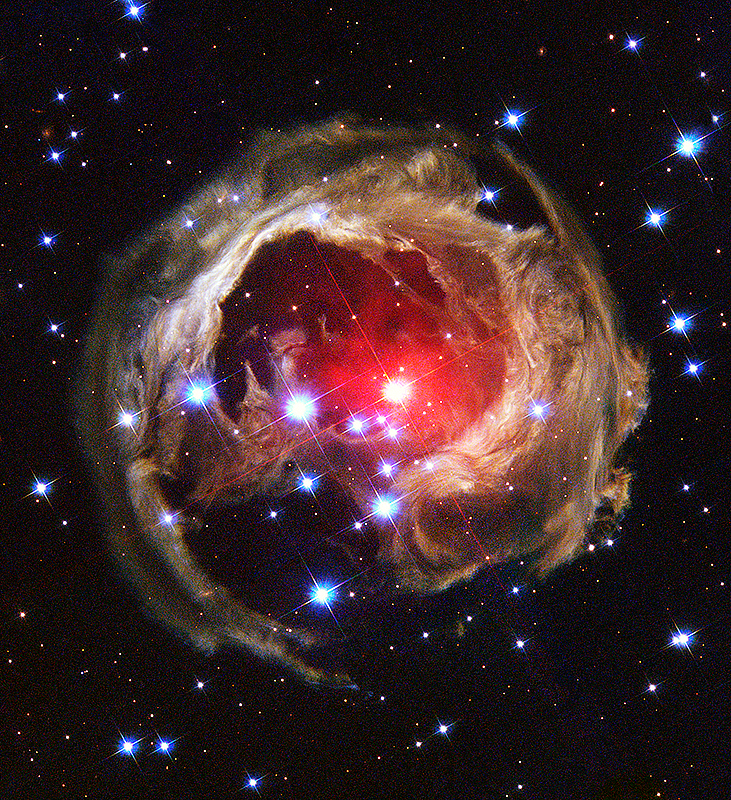
Modern astronomers refer to a star’s brightness as viewed from Earth as its apparent magnitude. But they have extended Hipparchus’s system to describe the actual brightness of stars, for which they use the term absolute magnitude. For technical reasons, they define a star’s absolute magnitude as what its apparent magnitude would be if it were 32.6 light-years from Earth.
Astronomers have also extended the system of magnitude numbers to include stars brighter than first magnitude and dimmer than sixth magnitude. A star that is brighter than first magnitude has a magnitude less than 1. For example, the apparent magnitude of Rigel is 0.12. Extremely bright stars have magnitudes less than zero—that is, their designations are negative numbers. The brightest star in the night sky is Sirius, with an apparent magnitude of –1.46. Rigel has an absolute magnitude of –8.1. According to astronomers’ present understanding of stars, no star can have an absolute magnitude much brighter than –8. At the other end of the scale, the dimmest stars detected with telescopes have apparent magnitudes up to 28. In theory, no star could have an absolute magnitude much fainter than 16.
Luminosity is the rate at which a star emits energy. The scientific term for a rate of energy emission is power, and scientists generally measure power in watts. For example, the luminosity of the sun is 400 trillion trillion watts. But astronomers do not usually measure a star’s luminosity in watts. Instead, they express luminosities in terms of the luminosity of the sun. They often say, for instance, that the luminosity of Alpha Centauri A is about 1.3 times that of the sun and that Rigel is about 40,000 times as luminous as the sun.
Luminosity is related to absolute magnitude in a simple way. A difference of 5 on the absolute magnitude scale corresponds to a factor of 100 on the luminosity scale. Thus, a star with an absolute magnitude of 2 is 100 times as luminous as a star with an absolute magnitude of 7. A star with an absolute magnitude of –3 is 100 times as luminous as a star whose absolute magnitude is 2 and 10,000 times as luminous as a star that has an absolute magnitude of 7.
Color and temperature.
If you look carefully at the stars, even without binoculars or a telescope, you will see a range of color from reddish to yellowish to bluish. For example, Betelgeuse looks reddish, Pollux—like the sun—is yellowish, and Rigel looks bluish.
A star’s color depends on its surface temperature. Astronomers measure star temperatures in a metric unit known as the kelvin. One kelvin equals exactly 1 Celsius degree (1.8 Fahrenheit degree), but the Kelvin and Celsius scales start at different points. The Kelvin scale starts at –273.15 °C. Therefore, a temperature of 0 K equals –273.15 °C, or –459.67 °F. A temperature of 0 °C (32 °F) equals 273.15 K.
Dark red stars have surface temperatures of about 2500 K. The surface temperature of a bright red star is approximately 3500 K; that of the sun and other yellow stars, roughly 5500 K. Blue stars range from about 10,000 to 50,000 K in surface temperature.

Although a star appears to the unaided eye to have a single color, it actually emits a broad spectrum (band) of colors. You can see that starlight consists of many colors by using a prism to separate and spread the colors of the light of the sun, a yellow star. The visible spectrum includes all the colors of the rainbow. These colors range from red, produced by the photons (particles of light) with the least energy; to violet, produced by the most energetic photons.
Visible light is one of six bands of electromagnetic radiation. Ranging from the least energetic to the most energetic, they are: radio waves, infrared rays, visible light, ultraviolet rays, X rays, and gamma rays. All six bands are emitted by stars, but most individual stars do not emit all of them. The combined range of all six bands is known as the electromagnetic spectrum.
Astronomers study a star’s spectrum by separating it, spreading it out, and displaying it. The display itself is also known as a spectrum. The scientists study thin gaps in the spectrum. When the spectrum is spread out from left to right, the gaps appear as vertical lines. The spectra of stars have dark absorption lines where radiation of specific energies is weak. In a few special cases in the visible spectrum, stars have bright emission lines where radiation of specific energies is especially strong.
An absorption line appears when a chemical element or compound absorbs radiation that has the amount of energy corresponding to the line. For example, the spectrum of the visible light coming from the sun has a group of absorption lines in the green part of the spectrum. Calcium in an outer layer of the sun absorbs light rays that would have produced the corresponding green colors.
Although all stars have absorption lines in the visible band of the electromagnetic spectrum, emission lines are more common in other parts of the spectrum. For instance, nitrogen in the sun’s atmosphere emits powerful radiation that produces emission lines in the ultraviolet part of the spectrum.
Size.
Astronomers measure the size of stars in terms of the sun’s radius. Alpha Centauri A, with a radius of 1.05 solar radii (the plural of radius), is almost exactly the same size as the sun. Rigel is much larger at 78 solar radii, and Antares has a huge size of roughly 700 solar radii.
A star’s size and surface temperature determine its luminosity. Suppose two stars had the same temperature, but the first star had twice the radius of the second star. In this case, the first star would be four times as bright as the second star. Scientists say that luminosity is proportional to radius squared—that is, multiplied by itself. Imagine that you wanted to compare the luminosities of two stars that had the same temperature but different radii. First, you would divide the radius of the larger star by the radius of the smaller star. Then, you would square your answer.
Now, suppose two stars had the same radius but the first star’s surface temperature—measured in kelvins—was twice that of the second star. In this example, the luminosity of the first star would be 16 times that of the second star. Luminosity is proportional to temperature to the fourth power. Imagine that you wanted to compare the luminosities of stars that had the same radius but different temperatures. First, you would divide the temperature of the warmer star by the temperature of the cooler star. Next, you would square the result. Then, you would square your answer again.
Mass.
Astronomers express the mass of a star in terms of the solar mass, the mass of the sun. For example, they give the mass of Alpha Centauri A as 1.08 solar masses; that of Rigel, as about 17 solar masses. The sun’s mass is about 2.2 × 1027 tons (2 × 1027 metric tons), which would be written out as 2 followed by 27 zeros.
Stars that have similar masses may not be similar in size—that is, they may have different densities. Density is the amount of mass per unit of volume. For instance, the average density of the sun is 88 pounds per cubic foot (1,400 kilograms per cubic meter), about 140 percent that of water. Sirius B has almost exactly the same mass as the sun, but it is 90,000 times as dense. As a result, its radius is only about 1/50 of a solar radius.
The Hertzsprung-Russell diagram
displays the main characteristics of stars. The diagram is named for astronomers Ejnar Hertzsprung of Denmark and Henry Norris Russell of the United States. Working independently of each other, the two scientists developed the diagram around 1910.
Luminosity classes.
Points representing the brightest stars appear toward the top of the H-R diagram; points corresponding to the dimmest stars, toward the bottom. These points appear in groups that correspond to different kinds of stars. In the 1930’s, American astronomers William W. Morgan and Philip C. Keenan invented what came to be known as the MK luminosity classification system for these groups. Astronomers revised and extended this system in 1978. In the MK system, the largest and brightest classes have the lowest classification numbers. The MK classes are: Ia, bright supergiant; Ib, supergiant; II, bright giant; III, giant; IV, subgiant; and V, main sequence or dwarf.
Because temperature also affects the luminosity of a star, stars from different luminosity classes can overlap. For example, Spica, a class V star, has an absolute magnitude of –3.2; but Pollux, a class III star, is dimmer, with an absolute magnitude of 0.7.
Spectral classes.
Points representing the stars with the highest surface temperatures appear toward the left edge of the H-R diagram; points representing the coolest stars, toward the right edge. In the MK system, there are eight spectral classes, each corresponding to a certain range of surface temperature. From the hottest stars to the coolest, these classes are: O, B, A, F, G, K, M, and L. Each spectral class, in turn, is made up of 10 spectral types, which are designated by the letter for the spectral class and a numeral. The hottest stars in a spectral class are assigned the numeral 0; the coolest stars, the numeral 9.
A complete MK designation thus includes symbols for luminosity class and spectral type. For example, the complete designation for the sun is G2V. Alpha Centauri A is also a G2V star, and Rigel’s designation is B8Ia.
Fusion in stars
A star’s tremendous energy comes from a process known as nuclear fusion. This process begins when the temperature of the core of the developing star reaches about 1 million K.
A star develops from a giant, slowly rotating cloud that consists almost entirely of the chemical elements hydrogen and helium. The cloud also contains atoms of other elements as well as microscopic particles of dust.
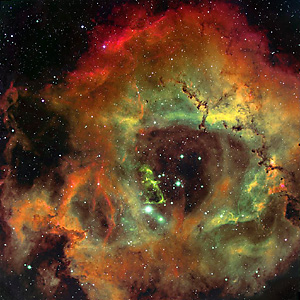
Due to the force of its own gravity, the cloud begins to collapse inward, thereby becoming smaller. As the cloud shrinks, it rotates more and more rapidly, just as spinning ice skaters turn more rapidly when they pull in their arms. The outermost parts of the cloud form a spinning disk. The inner parts become a roughly spherical clump, which continues to collapse.
The collapsing material becomes warmer, and its pressure increases. But the pressure tends to counteract the gravitational force that is responsible for the collapse. Eventually, therefore, the collapse slows to a gradual contraction. The inner parts of the clump form a protostar, a ball-shaped object that is no longer a cloud, but is not yet a star. Surrounding the protostar is an irregular sphere of gas and dust that had been the outer parts of the clump.
Combining nuclei.
When the temperature and pressure in the protostar’s core become high enough, nuclear fusion begins. Nuclear fusion is a joining of two atomic nuclei to produce a larger nucleus.
Nuclei that fuse are actually the cores of atoms. A complete atom has an outer shell of one or more particles called electrons, which carry a negative electric charge. Deep inside the atom is the nucleus, which contains almost all the atom’s mass. The simplest nucleus, that of the most common form of hydrogen, consists of a single particle known as a proton. A proton carries a positive electric charge. All other nuclei have one or more protons and one or more neutrons. A neutron carries no net charge, and so a nucleus is electrically positive. But a complete atom has as many electrons as protons. The net electric charge of a complete atom is therefore zero—the atom is electrically neutral.
However, under the enormous temperatures and pressures near the core of a protostar, atoms lose electrons. The resulting atoms are known as ions, and the mixture of the free electrons and ions is called a plasma.
Atoms in the core of the protostar lose all their electrons, and the resulting bare nuclei approach one another at tremendous speeds. Under ordinary circumstances, objects that carry like charges repel each other. However, if the core temperature and pressure become high enough, the repulsion between nuclei can be overcome and the nuclei can fuse. Scientists commonly refer to fusion as “nuclear burning.” But fusion has nothing to do with ordinary burning or combustion.
Converting mass to energy.
When two relatively light nuclei fuse, a small amount of their mass turns into energy. Thus, the new nucleus has slightly less mass than the sum of the masses of the original nuclei. The German-born American physicist Albert Einstein discovered the relationship E = mc-squared (E=mc 2) that indicates how much energy is released when fusion occurs. The symbol E represents the energy; m, the mass that is converted; and c-squared (c 2), the speed of light squared.
The speed of light is 186,282 miles (299,792 kilometers) per second. This is such a large number that the conversion of a tiny quantity of mass produces a tremendous amount of energy. For example, complete conversion of 1 gram of mass releases 90 trillion joules of energy. This amount of energy is roughly equal to the quantity released in the explosion of 22,000 tons (20,000 metric tons) of TNT. This is much more energy than was released by the atomic bomb that the United States dropped on Hiroshima, Japan, in 1945 during World War II. The energy of the bomb was equivalent to the explosion of 13,000 tons (12,000 metric tons) of TNT.
Destruction of light nuclei.
In the core of a protostar, fusion begins when the temperature reaches about 1 million K. This initial fusion destroys nuclei of certain light elements. These include lithium 7 nuclei, which consist of three protons and four neutrons. In the process involving lithium 7, a hydrogen nucleus combines with a lithium 7 nucleus, which then splits into two parts. Each part consists of a nucleus of helium 4—two protons and two neutrons. A helium 4 nucleus is also known as an alpha particle.
Hydrogen fusion.
After the light nuclei are destroyed, the protostar continues to contract. Eventually, the core temperature reaches about 10 million K, and hydrogen fusion begins. The protostar is now a star.
In hydrogen fusion, four hydrogen nuclei fuse to form a helium 4 nucleus. There are two general forms of this reaction: (1) the proton-proton (p-p) reaction and (2) the carbon-nitrogen-oxygen (CNO) cycle.
The p-p reaction
can occur in several ways, including the following four-step process:
(1) Two protons fuse. In this step, two protons collide, and then one of the protons loses its positive charge by emitting a positron. The proton also emits an electrically neutral particle called a neutrino.
A positron is the antimatter equivalent of an electron. It has the same mass as an electron but differs from the electron in having a positive charge. By emitting the positron, the proton becomes a neutron. The new nucleus therefore consists of a proton and a neutron—a combination known as a deuteron.
(2) The positron collides with an electron that happens to be nearby. As a result, the two particles annihilate each other, producing two gamma rays.
(3) The deuteron fuses with another proton, producing a helium 3 nucleus, which consists of two protons and one neutron. This step also produces a gamma ray.
(4) The helium 3 nucleus fuses with another helium 3 nucleus. This step produces a helium 4 nucleus, and two protons are released.

The CNO cycle
differs from the p-p reaction mainly in that it involves carbon 12 nuclei. These nuclei consist of six protons and six neutrons. During the cycle, they change into nuclei of nitrogen 15 (7 protons and 8 neutrons) and oxygen 15 (8 protons and 7 neutrons). But they change back to carbon 12 nuclei by the end of the cycle.
Fusion of other elements.
Helium nuclei can fuse to form carbon 12 nuclei. However, the core temperature must rise to about 100 million K for this process to occur. This high temperature is necessary because the helium nuclei must overcome a much higher repulsive force than the force between two protons. Each helium nucleus has two protons, so the repulsive force is four times as high as the force between two protons.
The fusion of helium is called the triple-alpha process because it combines three alpha particles to create a carbon 12 nucleus. Helium fusion also produces nuclei of oxygen 16 (8 protons and 8 neutrons) and neon 20 (10 protons and 10 neutrons).
At core temperatures of about 600 million K, carbon 12 can fuse to form sodium 23 (11 protons, 12 neutrons), magnesium 24 (12 protons, 12 neutrons), and more neon 20. However, not all stars can reach these temperatures.
As fusion processes produce heavier and heavier elements, the temperature necessary for further processes increases. At about 1 billion K, oxygen 16 nuclei can fuse, producing silicon 28 (14 protons, 14 neutrons), phosphorus 31 (15 protons, 16 neutrons), and sulfur 32 (16 protons, 16 neutrons).
Fusion can produce energy only as long as the new nuclei have less mass than the sum of the masses of the original nuclei. Energy production continues until nuclei of iron 56 (26 protons, 30 neutrons) begin to combine with other nuclei. When this happens, the new nuclei have slightly more mass than the original nuclei. This process therefore uses energy, rather than producing it.
Evolution of stars
The life cycles of stars follow three general patterns, each associated with a range of initial mass. There are (1) high-mass stars, which have more than roughly 8 to 11 solar masses; (2) low-mass stars, with 0.08 to 0.5 solar mass; and (3) intermediate-mass stars, with masses in between—the group that includes the sun. The exact ranges of mass differ somewhat according to the chemical composition of the star. Objects with less than 0.08 solar mass do not have enough gravitational force to produce the core temperature necessary for hydrogen fusion.
The life cycles of single stars are simpler than those of binary systems, so this section discusses the evolution of single stars first. And because astronomers know much more about the sun than any other star, the discussion begins with the development of intermediate-mass stars.
Intermediate-mass stars.
A cloud that eventually develops into an intermediate-mass star takes about 100,000 years to collapse into a protostar. As a protostar, it has a surface temperature of about 4000 K. It may be anywhere from a few times to a few thousand times as luminous as the sun, depending on its mass.
T-Tauri phase.
When hydrogen fusion begins, the protostar is still surrounded by an irregular mass of gas and dust. But the energy produced by hydrogen fusion pushes away this material as a protostellar wind. In many cases, the disk that is left over from the collapse channels the wind into two narrow cones or jets. One jet emerges from each side of the disk at a right angle to the plane of the disk. The protostar has become a T-Tauri star, a type of object named after the star T in the constellation Taurus (the Bull). A T-Tauri star is a variable star, one that varies in brightness.
Main-sequence phase.
The T-Tauri star contracts for about 10 million years. It stops contracting when its tendency to expand due to the energy produced by fusion in its core balances its tendency to contract due to gravity. By this time, hydrogen fusion in the core is supplying all the star’s energy. The star has begun the longest part of its life as a producer of energy from hydrogen fusion, the main-sequence phase. The name of this phase comes from a part of the H-R diagram.
Any star—whatever its mass—that gets all its energy from hydrogen fusion in its core is said to be “on the main sequence” or “a main-sequence star.” The amount of time a star spends there depends on its mass. The greater a star’s mass, the more rapidly the hydrogen in its core is used up, and therefore the shorter is its stay on the main sequence. An intermediate-mass star remains on the main sequence for tens of millions to tens of billions of years.
Red giant phase.
When all the hydrogen in the core of an intermediate-mass star has fused into helium, the star changes rapidly. Because the core no longer produces fusion energy, gravity immediately crushes matter down upon it. The resulting compression quickly heats the core and the region around it. The temperature becomes so high that hydrogen fusion begins in a thin shell surrounding the core. This fusion produces even more energy than had been produced by hydrogen fusion in the core. The extra energy pushes against the star’s outer layers, and so the star expands enormously.
As the star expands, its outer layers become cooler, so the star becomes redder. And because the star’s surface area expands greatly, the star also becomes brighter. The star is now a red giant.
Helium-burning phase.
Eventually, the core becomes hot enough to support the triple-alpha process. In red giants that are less than about 2.3 times as massive as the sun, helium fusion begins rapidly in an explosive event called the helium flash. The star briefly increases in brightness, then decreases in size and brightness until the energy from the helium fusion stops the core’s contraction. At the end of this period, the star is in its horizontal branch phase, named for the position of the point representing the star on the H-R diagram. Depending on its composition, a horizontal-branch star may remain red or become hotter and more yellow or blue in appearance.
In red giants that are more than about 2.3 times as massive as the sun, helium fusion begins gradually. The star shrinks slightly and becomes less bright as helium fusion begins. As the helium fusion continues, and the energy from it stops the core’s contraction, the star will get somewhat hotter and become more orange in appearance. As the helium gets consumed, the star again becomes cooler and more reddish in appearance.
Asymptotic giant phase.
Stars burn helium roughly 10 to 20 percent as long as they burned hydrogen. When all the helium in the core has fused, the core contracts, becoming hotter. The triple-alpha process begins in a shell surrounding the core, and hydrogen fusion continues in a shell surrounding that. Due to the increased energy produced by the burning in the shells, the star’s outer layers expand. The star becomes a giant again, but it is brighter than it was the first time.
On the H-R diagram, the point representing the star has moved upward and to the right along a line known as the asymptotic << as ihm TOT ihk >> giant branch (AGB). The star is therefore called an AGB star.
An AGB star’s core is so hot and its gravitational grip on its outermost layers is so weak that those layers blow away in a stellar wind. As each layer blows away, a hotter layer is exposed. Thus, the stellar wind becomes even stronger. Out in space, a succession of new, fast winds slam into old, slow winds that are still moving away from the star. The collisions produce dense shells of gas, some of which cool to form dust.
White dwarf phase.
In just a few thousand years, all but the hot core of an AGB star blows away, and fusion ceases in the core. The core illuminates the surrounding shells. Such shells looked like planets through the crude telescopes of astronomers who studied them in the 1800’s. As a result, the astronomers called the shells planetary nebulae—and today’s astronomers still do. The word nebulae is Latin for clouds. 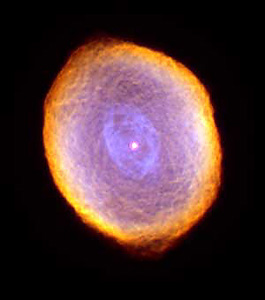
After a planetary nebula fades from view, the remaining core is known as a white dwarf star. This kind of star consists mostly of carbon and oxygen. Its initial temperature is about 100,000 K.
Black dwarf phase.
Because a white dwarf star has no fuel remaining for fusion, it becomes cooler and cooler. Over billions of years, it cools more and more slowly. Eventually, it becomes a black dwarf—an object too faint to detect. A black dwarf represents the end of the life cycle of an intermediate-mass star.
High-mass stars,
form quickly and have short lives. A high-mass star forms from a protostar in about 10,000 to 100,000 years.
High-mass stars on the main sequence are hot and blue. They are 1,000 to 1 million times as luminous as the sun, and their radii are about 10 times the solar radius. High-mass stars are much less common than intermediate- and low-mass stars. Because they are so bright, however, high-mass stars are visible from great distances, and so many are known.
A high-mass star has a strong stellar wind. A star of 30 solar masses can lose 24 solar masses by stellar wind before its core runs out of hydrogen and it leaves the main sequence.
As a high-mass star leaves the main sequence, hydrogen begins to fuse in a shell outside its core. As a result, its radius increases to about 100 times that of the sun. However, its luminosity decreases slightly. Because the star is now emitting almost the same amount of energy from a much larger surface, the temperature of the surface decreases. The star therefore becomes redder.
As the star evolves, its core heats up to 100 million K, enough to start the triple-alpha process. After about 1 million years, helium fusion ends in the core but begins in a shell outside the core. And, as in an intermediate-mass star, hydrogen fuses in a shell outside that. The high-mass star becomes a bright red supergiant.
When the contracting core becomes sufficiently hot, carbon fuses, producing a variety of elements, including oxygen, neon, sodium, and magnesium. Red supergiants that are less than roughly 11 times as massive as the sun stop fusing elements when the carbon is exhausted. Such a star then starts cooling and will eventually become a white dwarf. But in most red supergiants, the star goes on to fuse heavier and heavier elements in stages. Each time the fusion of a particular element ceases in the core, it continues in a thin shell surrounding the core. Eventually, the star’s central region takes on a layered appearance resembling an onion, with an iron core surrounded by successive shells fusing primarily silicon, oxygen, neon, carbon, helium, and hydrogen.
The fusion of each successive element in the core takes less time. A red supergiant 25 times more massive than the sun and with a similar chemical composition might fuse helium for about 700,000 years, carbon for 1,000 years, neon for 9 months, oxygen for 4 months, and silicon for about 1 day. 
Supernovae.
At this time, the radius of the iron core is about 1,900 miles (3,000 kilometers). Because further fusion would consume energy, the star is now doomed. It cannot produce any more fusion energy to balance the force of gravity.
When the mass of the iron core reaches 1.4 solar masses, violent events occur. The force of gravity within the core causes the core to collapse. As a result, the core temperature rises to nearly 10 billion K. At this temperature, the iron nuclei break down into lighter nuclei and eventually into individual protons and neutrons. As the collapse continues, protons combine with electrons, producing neutrons and neutrinos. The neutrinos carry away about 99 percent of the energy produced by the crushing of the core.
Now, the core consists of a collapsing ball of neutrons. When the radius of the ball shrinks to about 6 miles (10 kilometers), the ball rebounds like a solid rubber ball that has been squeezed.
All the events from the beginning of the collapse of the core to the rebounding of the neutrons occur in about one second. But more violence is in store. The rebounding of the ball of neutrons sends a spherical shock wave outward through the star. Much of the energy of the wave causes fusion to occur in overlying layers, creating new elements. As the wave reaches the star’s surface, it boosts temperatures to 200,000 K. As a result, the star explodes, hurling matter into space at speeds of about 9,000 to 25,000 miles (15,000 to 40,000 kilometers) per second. The brilliant explosion is known as a Type II supernova.
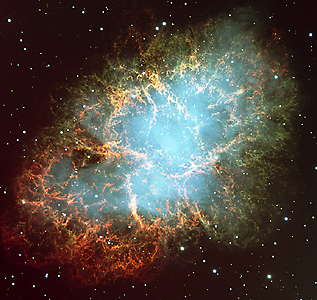
Three generations of stars may exist. Astronomers have not found any of what would be the oldest generation, Population III, stars. But they have found members of the other two generations. Population II stars, which would be the second generation, contain relatively small amounts of heavy elements. The more massive ones aged and died quickly, thereby contributing more nuclei of heavy elements to the clouds. For this reason, Population I stars, the third generation, contain the largest amounts of heavy elements. Yet these quantities are tiny compared with the amount of hydrogen and helium in Population I stars. For example, elements other than hydrogen and helium make up from 1 to 2 percent of the mass of the sun, a Population I star.
Neutron stars.
After a Type II supernova blast occurs, the stellar core remains behind. If the core has less than about 3 solar masses, it becomes a neutron star. This object consists almost entirely of neutrons. It packs at least 1.4 solar masses into a sphere with a radius of about 6 to 10 miles (10 to 15 kilometers).
Neutron stars have initial temperatures of 10 million K, but they are so small that their visible light is difficult to detect. However, astronomers have detected pulses of radio energy from neutron stars, sometimes at a rate of almost 1,000 pulses per second.
A neutron star actually emits two continuous beams of electromagnetic radiation, typically radio energy. The beams flow away from the star in opposite directions. As the star rotates, the beams sweep around in space like searchlight beams. If one of the beams periodically sweeps over Earth, scientific instruments can detect it as a series of pulses—one pulse for each revolution of the star. A star that is detected in this way is known as a pulsar.
In 1979, scientists first observed high-energy radiation from a type of neutron star similar to a typical pulsar, but with a magnetic field 100 to 1000 times as strong. These rare neutron stars were later called magnetars.
Black holes.
If the stellar core remaining after the supernova explosion has about 3 or more solar masses, no known force can support it against its own gravitation. The core collapses to form a black hole, a region of space whose gravitational force is so strong that nothing can escape from it. A black hole is invisible because it traps even light. All its matter is located at a single point in its center. This point, known as a singularity, is much smaller than an atomic nucleus.
Low-mass stars,
ranging from 0.08 to 0.5 solar mass, have surface temperatures less than about 4,500 K. Their luminosities are less than 2 percent of the solar luminosity. Low-mass stars use hydrogen fuel so slowly that they may shine as main-sequence stars for tens of billions to even several trillions of years. This life span is longer than the present age of the universe, believed to be about 14 billion years. Therefore, no low-mass star has ever died. Nevertheless, astronomers have determined that low-mass stars will never fuse anything but hydrogen. Thus, as these stars die, they will not pass through a red-giant phase. Instead, they will merely cool to become white dwarfs, then black dwarfs. 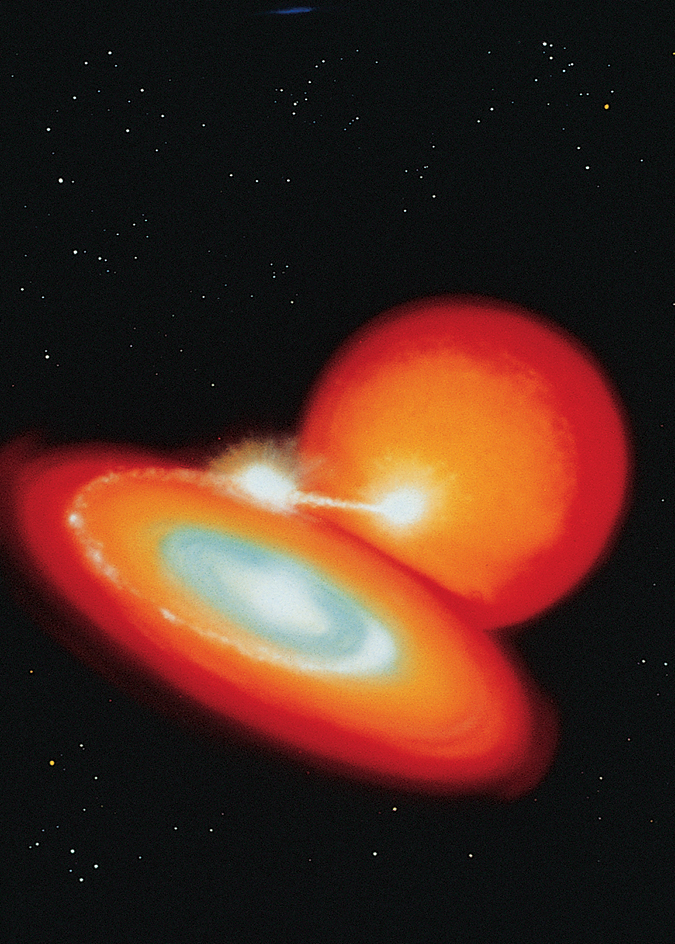
Binary stars
develop from two protostars that form near each other. More than 50 percent of what seem to the unaided eye to be single stars are actually binaries.

This process, called mass transfer, can take many forms. Mass transfer from a red giant onto a main-sequence companion can add absorption lines of carbon or other elements to the spectrum of the main- sequence star. But if the stars are close together, the material will flow in the opposite direction when the giant star becomes a white dwarf. The matter will spiral in toward the dwarf, forming a hot disk around it. The disk will flare brilliantly in visible and ultraviolet radiation.
If the giant star leaves behind a neutron star or a black hole instead of a white dwarf, an X-ray binary may form. In this case, the matter transferred from the main-sequence star will become extremely hot. When this matter strikes the surface of the neutron star or is pulled into the black hole, it will emit X rays.
In a third case, the red giant becomes a white dwarf, and the main-sequence star becomes a red giant. When enough gas from the giant accumulates on the dwarf’s surface, gas nuclei will fuse violently in a flash called a nova. In some cases, so much gas will accumulate that its weight will cause the dwarf to collapse. Almost instantly, the dwarf’s carbon will fuse, and the entire dwarf will explode in a Type I supernova. This kind of explosion is so bright that it can outshine an entire galaxy for a few months.
Astronomers have also observed a class of binary star often called a blue straggler. These stars are large, hot blue stars that appear younger than other stars of the same type. Because blue stars burn their fuel quickly, they have relatively short lives. A blue straggler extend its life by pulling matter from its binary partner, often a red giant. The fuel pulled from the partner extends the life of the blue straggler and makes the star appear younger.
